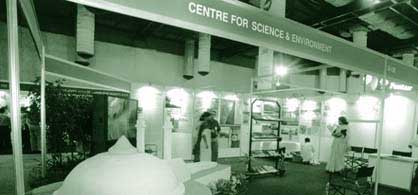|
Water Asia 2000 was organised in New Delhi between 18th and 20th of September. The Centre for Science and Environment (CSE) was the only NGO to participate. Apart from India were participants from Japan, US, Italy and several other countries. While all the other participants exhibited technologies for water treatment, wastewater treatment, pumps, valves, pipes, and heavy duty machinery, CSE’s stall was unique. It emphasised on the need and potential of water harvesting. Both in rural and urban areas. Centrally located, the stall displayed several panels pertaining to rural and urban water harvesting. One of the panels exhorted communities to think: water problems? Don’t look down, look up, basically exhorting people to tap rainwater. Three water-related films – one on pollution in the river Yamuna, one on the revival of the Arvari river in Alwar district of Rajasthan and one entitled ‘Water Works India,’ based on four water harvesters were shown through the day. In spite of the fact that the exhibition centered around technology and hardware, several visitors thronged the stall. These included business persons, professionals, students and others. Given below are some of the comments by the visitors.
Self-Employed Women’s Association (SEWA), an Ahmedabad based organisation has launched a water campaign in Gujarat to empower women, the primary user group, to demand a safe and sustainable water supply at the village level. The campaign works towards integrating the three Ws — women, water and work. Mobilising women to manage local water resources has made this possible, resulting in enhancing income levels and creating new economic opportunities. As part of SEWA’s water campaign, women have successfully constructed plastic-lined pond and rooftop water harvesting tanks in a number of arid villages. Efforts have been also made towards implementing watershed development measures to conserve water. Unused wells are being repaired, tanks de-silted and checkdams constructed. Women have formed water committees and set up water funds for the maintenance of water structures. There have been instances where women have been trained as ‘barefoot technicians’ to repair and maintain handpumps. The impact of SEWA’s intervention is apparent with the transformation in the socio-economic conditions of the villages. Apart from developing water sources at the village level, women have largely benefited from the employment opportunities generated at the local level. Women have been employed in artisan work, handicrafts, gum collection and salt manufacture in naturally hostile terrains. Productivity levels have increased, which in turn has led to enhanced incomes and increased savings. The other benefits of this water initiative have been exemplified in form of improved women’s health, which normally is the lowest in the priority; safe motherhood; safe childbirth; lower infant mortality; increased social security for woman and child; and, most importantly, reduced migration during the lean season. Augmentation of water sources has also ensured food and fodder security. SEWA’s is an example of what the collective strength of women can achieve. In order to replicate this example and to deal with water there is a need to integrate the requirements of the stakeholders, facilitate capital formation, build capacities of women organisations and promote social security. For further informationReema Nanavaty, Self-Employed Women’s Association, Opposite Lok Manya Tilak Baug, Bhadra, Ahmedabad – 380 001 Tel: 6506444, 5506491, 5506447, 5507365 E-mail: sewamahila@wilnetonline.net |

